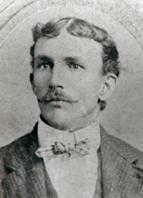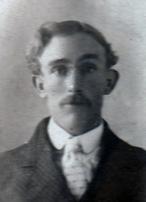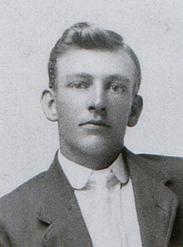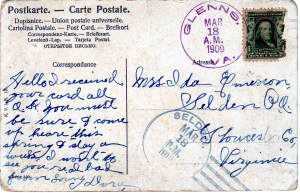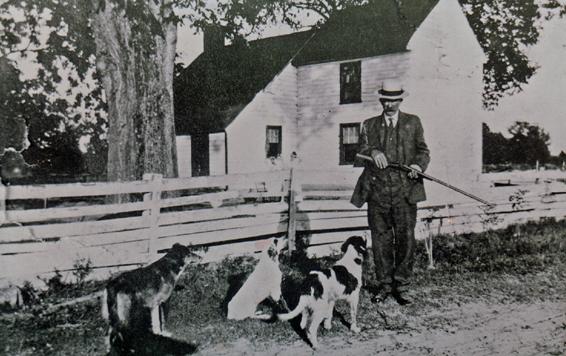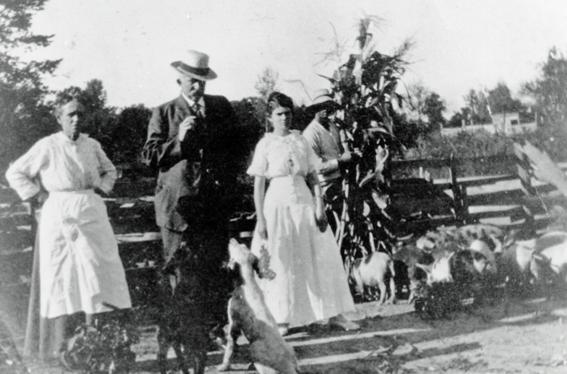George Edwin Emerson — Ida Catherine Goode
1858-1940 1860-1931
George Edwin Emerson was born in Queen Anne’s County, Maryland, on April 2, 1858. George Edwin was the first of five generations of “George Emersons,” none of whom had the same middle name. There is a wide discrepancy among the various documents concerning the year of George Edwin’s birth. The date ranges from 1856 to 1859. The most reliable sources, such as the 1870 census and his marriage record, state that Queen Anne’s, Maryland, is George Edwin’s birthplace; however, several other documents say that he was born in Pennsylvania. After the Emersons arrived in Gloucester, Molly Emerson moved to Lancaster, Pennsylvania, her mother’s birthplace, and married John Rambo. It seems that “Aunt Molly” was the only connection that the Emersons maintained with their out-of-state relatives after coming to Gloucester; therefore, later generations thought they had come from Pennsylvania.
Ida Catherine Goode was born on February 27, 1861, in Gloucester County, Virginia. This is well documented without any discrepancies.
While Alexander Emerson was passing through the northern portion of Gloucester on his migration to King and Queen, he noticed a woman plowing her field with a yoke of oxen. Inquiring of a neighbor, he discovered that she was Mary Catherine Goode, the widow of James T. Goode who had died in the Civil War. Sympathizing with her dire circumstances, he sent his teenage son, George, to help her with the planting and harvesting of the crops. Thus, George Edwin Emerson met Ida Catherine Goode. In the course of time, they fell in love and were married on August 15, 1878.
George and Ida lived with Mary Catherine Goode for several years after their marriage and worked within the operation of the family farm. The Gloucester County 1880 census lists Mary C. Goode as the head of household, John T., her son as farmer, Ida Emerson, her daughter, George E., her son-in-law, as a laborer, and Charles Lewis.
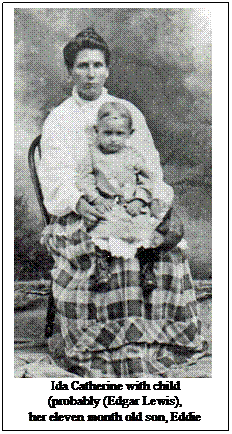 Being a laborer on a farm in the 1880s was not an easy occupation. Farm machinery was in its very elementary stages; for example, wheat was harvested with a “cradle.” A scythe, an implement with a long curved single-edged blade and a long bent handle, was used to cut hay or to clear undergrowth. When harvesting grain, a basket-like device was attached to the scythe to catch the grain. A great deal of strength was required to lift the cradle and swing it with enough force to cut the wheat or rye. As more and more of the harvest fell into the cradle, it became heavier and heavier. George Edwin Emerson seems to have met the challenge of this strenuous occupation and gained respect for his strength and skill. It was said that “George Emerson could cradle more wheat than any man in Gloucester County.”
Being a laborer on a farm in the 1880s was not an easy occupation. Farm machinery was in its very elementary stages; for example, wheat was harvested with a “cradle.” A scythe, an implement with a long curved single-edged blade and a long bent handle, was used to cut hay or to clear undergrowth. When harvesting grain, a basket-like device was attached to the scythe to catch the grain. A great deal of strength was required to lift the cradle and swing it with enough force to cut the wheat or rye. As more and more of the harvest fell into the cradle, it became heavier and heavier. George Edwin Emerson seems to have met the challenge of this strenuous occupation and gained respect for his strength and skill. It was said that “George Emerson could cradle more wheat than any man in Gloucester County.”
Eventually, George and Ida left the home of Mary Catherine Goode and ventured out on a life of their own. In 1887, they were living in King and Queen County. Although George William said that he was born in West Point, his birth is recorded in King and Queen. George and Ida’s home was on the Mattaponi River in sight of West Point; thus, one could easily refer to his residence as West Point.
By this time, George and Ida had three sons: Edgar Lewis born in 1879, John Thomas born in 1881,
and George William was born in January 1, 1887. In order to distinguish between the father George and the son George, the father was called Big George and the son Little George; even after George William became an adult who was six foot three and weighed 220 pounds, he was still called Little George.
Around 1890, George Edwin leased South White Marsh Farm, and the Emerson family returned to the southern section of Gloucester. George William said this move was made when he was three years old, hence the 1890 date; this is also confirmed by the birth date of George and Ida’s fourth son, Frank Mark, who was born in 1892 in Gloucester. Ida also gave birth to twins, a boy and a girl, who died in infancy.
South White Marsh was an 838 acre tract of land with a substantial portion being wooded. When South White Marsh was sold in 1913 to Dick Roane and Willie Ashe, a clause was included in the contract of sale that George E. Emerson’s lease would be honored by the new owners.
 Ida Catherine in front of the home at South White Marsh
Ida Catherine in front of the home at South White Marsh
This postcard received by Ida in 1909 verifies that the family was living in the White Marsh area at that date.
Big George with his beloved dogs at South White Marsh
Big George Emerson continued to be noted for his strength. Newcomb’s General Store was located at White Marsh; the men of the neighborhood often gathered on the large porch that extended across the front of the store to socialize. One day when merchandise was being delivered in a horse drawn wagon, the delivery man was having difficulty getting a barrel of molasses off the wagon. Someone said, “I’ll bet Big George Emerson could take that barrel of molasses in the store by himself.” After a bit of negotiation, the bet was on: if Big George could carry the barrel of molasses into the store, it would be his free. After Big George got the barrel of molasses on his shoulder, he started up the steps, but the weight of the man and the molasses was too much for the deteriorating wooden steps, and the first riser broke. Big George managed to maintain his balance and continued up the step and into the store. In addition to winning the barrel of molasses, he gained the unofficial title of being the strongest man in Gloucester County.
It seems that George Edwin was somewhat of an early-day entrepreneur; he often had a scheme to make his livelihood more profitable. One such endeavor was to corner the molasses market in Gloucester. (Molasses must have been a more substantial part of the diet at the turn of the century than it is today.) George Edwin planted a crop of sorghum and purchased the equipment to process the manufacture of molasses. The process involved keeping a fire in the machine, cutting the sorghum while it was still green, and maintaining the proper temperature during the cooking. All told, it was a very laborious process. The endeavor gained some notoriety in Gloucester but was not a financial success.
Another of George Edwin’s enterprises was related to the transportation business. At the turn of the century, commerce in Gloucester County was in transition from river travel to overland transportation. As long as the steamboats were making regular routes through the rivers of Gloucester as they traveled from Norfolk to Baltimore, farmers had adequate means of transporting their produce to the markets of those cities. However, as the steamboat industry began to wane, a transportation need arose in Gloucester. George Edwin sought to meet this need by buying a sailboat, The Leatherberry, which was large enough to carry cargo from Gloucester to Norfolk. The Leatherberry’s maiden voyage was to transport a load of watermelons to Norfolk. George Edwin, teenaged George William, and several hired hands set sail from Roane’s wharf. Many years later, George William said, “On the first day, everything went fine. But on the second day, there came a calm. We sat in the middle of the Chesapeake Bay for three days without moving because there was no wind. We had nothing to eat but watermelons. We tried fishing but without much luck. On the third day, we saw a big turtle surface not to far from The Leatherberry. Two of the hired men put the lifeboat overboard and paddled to the turtle. They succeeded in catching the turtle by his back legs, but when the turtle began to submerge, the lifeboat all but capsized. We still had nothing to eat but watermelons. By the time the wind picked up and we began moving, the watermelons had spoiled; all we could do was return home.” After this, The Leatherberry died a slow death anchored offshore on the Severn River.
On October 17, 1917, H. N. Baruch bought South White Marsh (834 acres for $16,680); he also bought White Marsh and reunited the two farms under the same deed, making White Marsh Plantation the largest landholding under a single deed in Virginia. George E. Emerson’s lease was terminated, and the family then moved to Severn Hall. By this time, all of George and Ida’s children had left home except their son, Johnny, who never married and remained in their household as long as they lived. Later, George William Emerson’s family would also move to Severn Hall, living in a separate residence.
During their stay at Severn Hall, Big George, Little George, and Johnny worked together in the farming operation which was chiefly oriented toward raising beef. The chief cash crop was beef; that is, corn, hay, wheat and other crops were raised primarily to feed the cattle; selling the cattle was the source of income. When the cattle were butchered, Big George would take half and Little George would take the other half, and they would go door-to-door on a “beef route.” These were the days before refrigeration was a universal convenience, and the beef route was a means of families having fresh meat. Sometimes other meats were included, such as pork and fish.

“Grandfather and threshing time — Lois” is written on the back of this picture
Ida, Big George, Maude (Frank’s wife), Little George
One of the disadvantages of living at Severn Hall was its isolation. The dirt road leading to the homeplace was one and a half miles long, and during the rainy season of the winters, the road became nearly impassable. This was especially troublesome to Ida who was a faithful member of Oak Grove Methodist Church. On Sundays when it was impossible for her to go to church, Ida conducted her own services in her bedroom where she had a pump organ. She would read the Bible aloud, play the organ, and always sing “Trust and Obey.”
At Severn Hall, George and Ida grew old together. Big George had once held the unofficial title of being the strongest man in Gloucester, but now it was jokingly said that if he saw someone doing a strenuous job, he would say, “Do you need any help? If you do, I’ll call George and Johnny.”
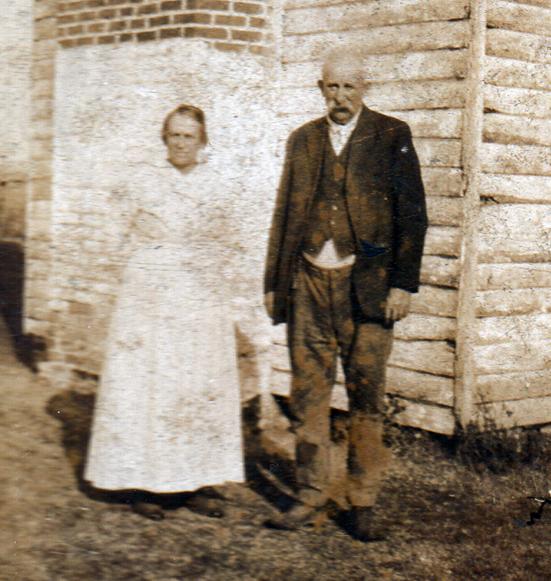 Ida and Big George at Severn Hall
Ida and Big George at Severn Hall
In the early 1930s, Ida became ill with what was said to be yellow jaundice. Today it is known that jaundice is a symptom of what is usually a more serious disease; probably she had a severe liver problem. On October 8, 1931, Ida Catherine Emerson died. The following obituary appeared in The Gloucester Gazette on October 22, 1931:
IN MEMORIAM
Departed this life on October 8, 1931, Mrs. Ida Catherine Emerson, in the 71st year of her age, born February 27, 1861, the only daughter of her parents, John Thomas Goode and Mary Catherine Goode. She united with New Hope M. E. Church in early childhood, where she held her membership until about 34 years ago she transferred to Oak Grove. She was a consistent Christian: through all the trials and temptations of this life her faith in God never faltered or failed. She bore her suffering patiently,without a murmur, and expressed her willingness to leave this life in exchange for the better one above.
Fifty-four years ago, August 18, 1877, she married George Edwin Emerson, of Pennsylvania. She was the mother of six children, two of whom died in infancy. She was a devoted wife and mother, a kind neighbor and a loyal friend. She leaves to mourn their loss, besides a brother, John Thomas Goode; her husband, and four sons, who are Edgar Lewis, John Thomas, and George William Emerson of Gloucester and Frank Mark Emerson of Detroit, Mich., and 16 grandchildren.
All was done for her that medical skill and loving hands could do, but our Heavenly Father, who is too good to err and too wise to make a mistake saw fit to take her from her earthly home to dwell in that beautiful land not made with hands. She was laid to rest in the cemetery at New Hope in the presence of a large concourse of friends and relatives attesting to the high esteem in which she was held.
By one of her Loved ones
The Emersons at Severn Hall in the late 1930s
Frank, Eddie, Little George, Johnny, Big George
About the time of Ida’s death, George Edwin purchased one of those modern conveniences known as an automobile. On his way to visit Little George’s family at Catlett’s Place, George Edwin seemed to have been traveling too fast on a curve in the road and overturned the vehicle. He sustained an injury to his head from which he never fully recovered. George and his son Johnny continued living at Severn Hall until George Edwin became so enfeebled that he needed the support of a larger family setting. He moved in with the George William Emerson family at Airville Farm.

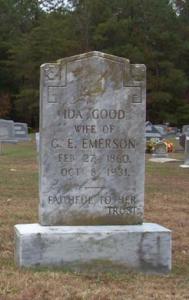 George Edwin Emerson died in 1940 at Airville Farm in Gloucester.
George Edwin Emerson died in 1940 at Airville Farm in Gloucester.
He was buried in New Hope Cemetery beside his beloved, Ida Catherine.


